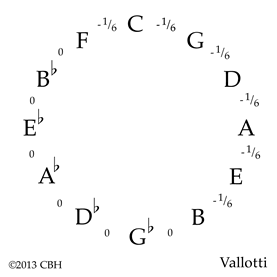Technical Library
TEMPERAMENTS XVIII: Vallotti
Entire Contents Copyright © 2013 CBHTechnical LibraryTEMPERAMENTS XVIII: Vallotti Entire Contents Copyright © 2013 CBH |
 WIKIMEDIA COMMONS / PUBLIC DOMAIN |
| Francesco Antonio Vallotti (1697–1780) |
Sometimes you may feel the need for a more versatile temperament, especially if you wish to play in a wide range of keys without retuning. Vallotti is a handy one for your bag of tricks. Francesco Antonio Vallotti (1697–1780) was an Italian theorist and composer in the first part of the eighteenth century who tempered his fifths a little less roughly by dividing the comma into six parts instead of only four, and leaving the remaining six fifths pure. Vallotti’s temperament is sometimes also known under the name of his fiddler friend Tartini, who published it in his Trattato di musica secondo la vera scienza dell’armonia (Padua, 1754). Half a century later, the English scientist Thomas Young proposed something very similar to the Royal Society—the only difference being that his tempered fifths ran around from C instead of F.
No matter what you call it, modern piano tuners, always well-trained at counting beats, find this temperament quite easy to learn to tune. (In fact, here is my article commissioned by the Australasian Piano Tuners & Technicians Association for their October 2013 Convention in Sydney.) Remember how scientific law says that for each octave you go up, the frequency doubles? Well, if they have to narrow six fifths twice as much as their beloved ones in equal temperament, all they need do is drop down an octave, and the beat speeds of the tempered fifths are miraculously exactly what they so diligently learned for Equal Temperament in their normal bearings octave!
Confused? Don’t worry: While Vallotti is a little more work than the previous temperaments, it’s well worth the extra effort. Here is one way you could go about it (and in the expectation that your colleagues are arriving after lunch for some pleasant music making, let’s do this one from the a' so we don’t get them offside right from the beginning):
1. Tune your a' (that’s the one in the octave above middle c' of course, but you knew that!) to a tuning fork, and tune a in absolute perfect tune an octave below it.
2. Now we want to find the f a third below that a: Tune it pure first of all, but then widen the interval by flattening the f until you hear three distinct beats per second. Look at the second hand on your watch if you must, and you should be able to match the slow wow-wow-wow of the interval without too much trouble.
3. Tune all the fifths from the flat side of F around the circle of keys absolutely pure. Don’t stop halfway and change direction like you did with Kirnberger, but continue right around until you hit B.
 4. Take a moment to contemplate what you have to do now. Look at the diagram
and you will see all the fifths in the circle between F and A which must be
narrowed somewhat, but not quite as much as the quarter comma to which you have
become so adept. Some people will make a great to do about various checks and
things to get all these tempered fifths exactly the same amount narrow, but
let’s not get involved with that. There is also the position of the E
to determine between the already in-tune A and B, so let’s begin there.
4. Take a moment to contemplate what you have to do now. Look at the diagram
and you will see all the fifths in the circle between F and A which must be
narrowed somewhat, but not quite as much as the quarter comma to which you have
become so adept. Some people will make a great to do about various checks and
things to get all these tempered fifths exactly the same amount narrow, but
let’s not get involved with that. There is also the position of the E
to determine between the already in-tune A and B, so let’s begin there.
5. Tune e' pure to a, then lower it a little, squeezing the interval so it has a perceptible but not overly blatant wave. Drop down the octave now to e, which of course must be tuned pure. Check this lower note against the b. If you are somewhere close, this interval of a fifth will also be a little narrow, and leisurely beating about once per second for those who would like to count such things. If it’s not, don’t move the b! Try shuffling the e around a little instead: Put it exactly where you want it, but remember if you move your e, you must also move your e', otherwise you will have a very noticeable octave out of tune, spoiling the rest of your good efforts.
6. Middle c' comes next. Tune it a pure fifth above your f, and then squeeze it a little so the resulting fifth with f sounds quite similar to the already tuned e–b interval—If anything, you could make it appear to beat just a tad faster, just a little more restless sounding.
7. All that remains now is the G and D, floating around somewhere in the middle of the circle as yet undetermined. Find your g' above middle c', again tuning the fifth pure and then squeezing it. (You’re a good deal higher up the keyboard now, so bear in mind that if this interval is the same theoretical size as the last, it’s going to beat just that more faster and trick you into thinking you have actually tuned it rougher: Every octave you go up doubles the beat speed.) Drop down the octave to the pure g.
8. Your d' is left. Jam it in between the g and the a', if that is the right phrase to use. First of all, tune it pure to g, and then just for fun observe what it sounds like when played with the a': This latter interval should obviously be (and sound) way too narrow. Commence your juggling act, lowering your d' little by little until your fifth g–d' sounds about the same as your expertly tuned f–c'.
9. If you’ve done reasonably well, your resulting d'–a' will probably just beat a little faster than c'–g', and the beat-counters will be pretty happy if when you check all your tempered fifths, each one seems to beat just a little more than the previous as you ascend the keyboard from e–b, f–c', g–d', a–e', c'–g' & d'–a'. All the other intermediate ones are pure: f♯–c♯', a♭–e♭', etc.
10. Take a breather now, put the rest of your instrument in tune with your bearings area, and play a well-earned piece.
These later well-temperaments do involve a bit more fussing, but are deservedly popular because of their versatility: Vallotti is one of the most often requested temperaments for ensemble use in late baroque and classical repertoire. If you dabble with fortepianos, you might like to try Vallotti for music as late as Beethoven and even some Schubert.
Further discussion
Anonymous [Kayano, Moxzan] Dodecagon — Chi-s akt temo Tokyo 2012, p87
Asselin, Pierre-Yves Musique et Tempérament Éditions Costallat, Paris 1985, p104 (“Tartini-Vallotti”)
Klop, G C Harpsichord Tuning Werkplaats voor Clavecimbelbouw, Garderen 1974, p26 (“Van Biezen, 1970”)
Padgham, Charles The Well-Tempered Organ Positive Press, Oxford 1986, p84
Veroli, Claudio di Unequal Temperaments Artes Graficas Farro, Buenos Aires 1978, p109
| Pitch nomenclature | |
| Harpsichord Tuning Process | |
| Tuning Bibliography | |
| Technical Library overview | |
| Harpsichords Australia Home Page |